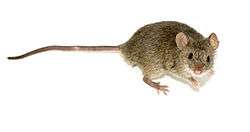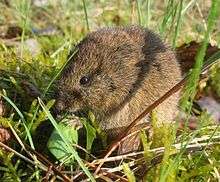Definify.com
Definition 2025
鼠
鼠
Translingual
| Stroke order | |||
|---|---|---|---|

| |||
Han character
鼠 (radical 208 鼠+0, 13 strokes, cangjie input 竹X女卜女 (HXVYV), four-corner 77717)
- Kangxi radical #208, ⿏ (“rat”).
References
- KangXi: page 1527, character 14
- Dai Kanwa Jiten: character 48390
- Dae Jaweon: page 2063, character 23
- Hanyu Da Zidian: volume 7, page 4772, character 1
- Unihan data for U+9F20
Chinese
|
simp. and trad. |
鼠 | |
|---|---|---|
| alt. forms | 鼡 | |
Glyph origin
| Historical forms of the character 鼠
| ||
|---|---|---|
| Oracle bone script | Large seal script | Small seal script |
 |
 |
 |
| Characters in the same phonetic series (鼠) (Zhengzhang, 2003) | |
|---|---|
| Old Chinese | |
| 鼠 | *hljaʔ |
| 癙 | *hljaʔ |
Pictogram (象形) – a mouse or rat.
Pronunciation
- Mandarin
- Cantonese (Jyutping): syu2
- Hakka (Sixian, PFS): chhú
- Min Dong (BUC): chṳ̄
- Min Nan (POJ): chhú / chhír / chhí / sú / sír / sí
- Wu (Wiktionary): tshr (T2)
- Mandarin
- (Standard Chinese, Beijing)+
- Pinyin:
- Zhuyin: ㄕㄨˇ
- Wade-Giles: shu3
- Gwoyeu Romatzyh: shuu
- IPA (key): /ʂu²¹⁴/
-

- (Standard Chinese, Beijing)+
- Cantonese
- (Standard Cantonese, Guangzhou)+
- Jyutping: syu2
- Yale: syú
- Cantonese Pinyin: sy2
- IPA (key): /ɕyː³⁵/
- (Standard Cantonese, Guangzhou)+
- Hakka
- (Sixian, incl. Miaoli and Meinong)
- Pha̍k-fa-sṳ: chhú
- Hakka Romanization System: cu`
- Hagfa Pinyim: cu3
- IPA: /t͡sʰu³¹/
- (Sixian, incl. Miaoli and Meinong)
- Min Dong
- (Fuzhou)
- Bàng-uâ-cê: chṳ̄
- IPA (key): /t͡sʰy³³/
- (Fuzhou)
- Min Nan
- (Hokkien: Xiamen, Taipei, Tainan, Magong)
- Pe̍h-ōe-jī: chhú
- Tâi-lô: tshú
- Phofsit Daibuun: zhuo
- IPA (Xiamen): /t͡sʰu⁵³/
- IPA (Taipei): /t͡sʰu⁵³/
- (Hokkien: Quanzhou, Lukang, Sanxia, Kinmen, Hsinchu)
- Pe̍h-ōe-jī: chhír
- Tâi-lô: tshír
- IPA (Quanzhou): /t͡sʰɯ⁵⁵⁴/
- (Hokkien: Zhangzhou, Kaohsiung, Yilan, Hsinchu, Taichung)
- Pe̍h-ōe-jī: chhí
- Tâi-lô: tshí
- Phofsit Daibuun: chie
- IPA (Zhangzhou): /t͡ɕʰi⁵³/
- IPA (Kaohsiung): /t͡ɕʰi⁴¹/
- (Hokkien: Xiamen)
- Pe̍h-ōe-jī: sú
- Tâi-lô: sú
- Phofsit Daibuun: suo
- IPA (Xiamen): /su⁵³/
- (Hokkien: Quanzhou)
- Pe̍h-ōe-jī: sír
- Tâi-lô: sír
- IPA (Quanzhou): /sɯ⁵⁵⁴/
- (Hokkien: Zhangzhou)
- Pe̍h-ōe-jī: sí
- Tâi-lô: sí
- Phofsit Daibuun: sie
- IPA (Zhangzhou): /ɕi⁵³/
- Note: chhí/chhír/chhú - vernacular; sú/sír/sí - literary; chhú - literary (Taiwan).
- (Hokkien: Xiamen, Taipei, Tainan, Magong)
- Wu
- (Shanghainese)
- Wiktionary: tshr (T2)
- IPA (key): /t͡sʰz̩³⁴/
- (Shanghainese)
- Dialectal data▼
| Variety | Location | 鼠 |
|---|---|---|
| Mandarin | Beijing | /ʂu²¹⁴/ |
| Harbin | /ʂu²¹³/ | |
| Tianjin |
/ʂu¹³/ /su¹³/ |
|
| Jinan | /ʂu⁵⁵/ | |
| Qingdao | /ʃu⁵⁵/ | |
| Zhengzhou | /ʂu⁵³/ | |
| Xi'an | /fu⁵³/ | |
| Xining | /fv̩⁵³/ | |
| Yinchuan |
/ʈ͡ʂʰu⁵³/ /ʂu⁵³/ |
|
| Lanzhou | /p͡fʰu⁴⁴²/ | |
| Ürümqi | /ʈ͡ʂʰu⁵¹/ | |
| Wuhan | /ɕy⁴²/ | |
| Chengdu | /su⁵³/ | |
| Guiyang | /su⁴²/ | |
| Kunming | /ʈ͡ʂʰu⁵³/ | |
| Nanjing | /ʈ͡ʂʰu²¹²/ | |
| Hefei | /ʈ͡ʂʰu²⁴/ | |
| Jin | Taiyuan | /su⁵³/ |
| Pingyao | /sz̩ʷ⁵³/ | |
| Hohhot | /su⁵³/ | |
| Wu | Shanghai | /t͡sʰz̩³⁵/ |
| Suzhou | /t͡sʰz̩ʷ⁵¹/ | |
| Hangzhou | /t͡sʰz̩ʷ⁵³/ | |
| Wenzhou | /t͡sʰei³⁵/ | |
| Hui | Shexian | /t͡ɕʰy³⁵/ |
| Tunxi | /t͡ɕʰy³¹/ | |
| Xiang | Changsha | /ɕy⁴¹/ |
| Xiangtan | /ɕy⁵⁵/ | |
| Gan | Nanchang | /ɕy²¹³/ |
| Hakka | Meixian | /t͡sʰu³¹/ |
| Taoyuan | /tʃʰu³¹/ | |
| Cantonese | Guangzhou | /sy³⁵/ |
| Nanning | /sy³⁵/ | |
| Hong Kong | /sy³⁵/ | |
| Min | Xiamen (Min Nan) |
/su⁵³/ /t͡sʰu⁵³/ |
| Fuzhou (Min Dong) | /t͡sʰy³²/ | |
| Jian'ou (Min Bei) | /t͡sʰy²¹/ | |
| Shantou (Min Nan) | /t͡sʰɯ⁵³/ | |
| Haikou (Min Nan) | /siu²¹³/ |
| Rime | |
|---|---|
| Character | 鼠 |
| Reading # | 1/1 |
| Initial (聲) | 書 (26) |
| Final (韻) | 魚 (22) |
| Tone (調) | Rising (X) |
| Openness (開合) | Open |
| Division (等) | III |
| Fanqie | 舒吕切 |
| Reconstructions | |
| Zhengzhang Shangfang |
/ɕɨʌX/ |
| Pan Wuyun |
/ɕiɔX/ |
| Shao Rongfen |
/ɕiɔX/ |
| Edwin Pulleyblank |
/ɕɨə̆X/ |
| Li Rong |
/ɕiɔX/ |
| Wang Li |
/ɕĭoX/ |
| Bernard Karlgren |
/ɕi̯woX/ |
| Expected Mandarin Reflex |
shǔ |
| Zhengzhang system (2003) | |
|---|---|
| Character | 鼠 |
| Reading # | 1/1 |
| No. | 11801 |
| Phonetic component |
鼠 |
| Rime group |
魚 |
| Rime subdivision |
0 |
| Corresponding MC rime |
|
| Old Chinese |
/*hljaʔ/ |
Definitions
鼠
Compounds
|
|
|
Japanese
Kanji
Readings
Etymology 1
| Kanji in this term |
|---|
| 鼠 |
|
ねずみ Hyōgaiji |
| kun'yomi |
Originally a compound of 根 (ne, “root”, more specifically signifying somewhere hidden away) + 住み (sumi, the 連用形 (ren'yōkei, “continuative or stem form”) of verb 住む sumu, “to live in a place, to reside”), meaning roughly “one who lives in hidden places”. The sumi changes to zumi as an instance of rendaku (連濁).
Pronunciation
Noun
鼠 (hiragana ねずみ, katakana ネズミ, romaji nezumi)
- (zoology) a mouse, a rat
- general term for members of superfamily Muroidea, including mice, rats, voles, hamsters, gerbils, and other similar rodents
- short for 鼠色 (nezumi iro): the colour grey, sometimes more specifically a dark grey colour
Usage notes
Japanese does not generally distinguish between mice and rats, and both are commonly called nezumi. If a distinction is needed, speakers may use the adjectives 大きい (ōkii, “large”) or 小さい (chīsai, “small”), or may use the word マウス (mausu, “mouse”, borrowed from either German or English).
As with many terms that name organisms, this term is often spelled in katakana in biological contexts, as ネズミ.
Note that, although the Japanese term 子年 (nezumidoshi, nedoshi) for The Year of the Rat in the Chinese zodiac does derive from this same nezumi term, it is not written with this 鼠 kanji.
Derived terms
|
Etymology 2
| Kanji in this term |
|---|
| 鼠 |
|
ねず Hyōgaiji |
| kun'yomi |
Abbreviation of nezumi. Used in some compounds.[2][3]
Pronunciation
Noun
Derived terms
|
Etymology 3
| Kanji in this term |
|---|
| 鼠 |
|
ね Hyōgaiji |
| kun'yomi |
Abbreviation of nezumi. Used in some compounds.[2][3]
Pronunciation
Noun
Derived terms
References
- ↑ 1998, NHK日本語発音アクセント辞典 (NHK Japanese Pronunciation Accent Dictionary) (in Japanese), Tōkyō: NHK, ISBN 978-4-14-011112-3
- 1 2 1988, 国語大辞典(新装版) (Kokugo Dai Jiten, Revised Edition) (in Japanese), Tōkyō: Shogakukan
- 1 2 3 2006, 大辞林 (Daijirin), Third Edition (in Japanese), Tōkyō: Sanseidō, ISBN 4-385-13905-9
Korean
Hanja
鼠 • (seo)
Eumhun:
- Sound (hangeul): 서 (McCune-Reischauer: sŏ, Yale: se)
- Name (hangeul): 쥐 서()
- This term needs a translation to English. Please help out and add a translation, then remove the text
{{rfdef}}.
Vietnamese
Han character
鼠 (thử)
- This term needs a translation to English. Please help out and add a translation, then remove the text
{{rfdef}}.


